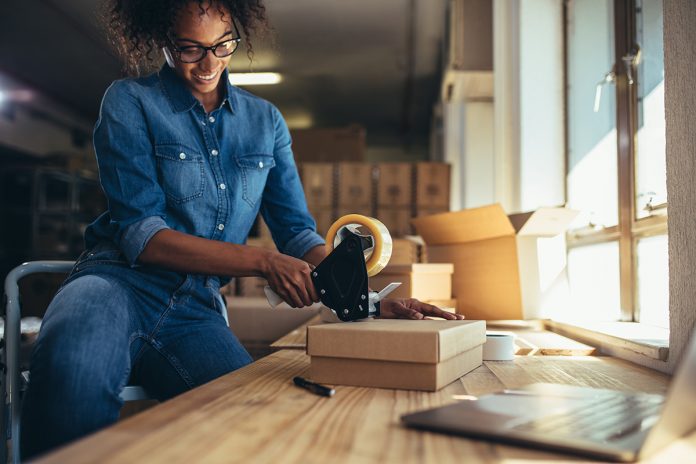Even before the coronavirus pandemic changed everything, the climate for conventional retail appeared headed for an ice age. As early as 2015, analysts put shopping malls on life support; by 2019, blueblood department stores like Barneys New York, Lord & Taylor, and Macy’s had shuttered multiple locations or declared bankruptcy or both. All blamed the rising popularity of online shopping and the legions of delivery vehicles ferrying everything from grocery basics to pre-fabricated buildings straight to consumers’ front doors.
But what about cannabis retail?
It’s hard to make business model comparisons between nascent and established industries, especially when one industry is subjected to a hodgepodge of state and local regulations with no comprehensive models or guidelines for shopping online or in stores. How consumers get their weed in legal states currently depends on what’s allowed by local officials in counties, cities, and small towns.
In areas that don’t allow cannabis retail storefronts or dispensaries or where stores are scarce, consumers may be limited to relying on licensed delivery services. For homebound patients, delivery always has been their only option. The black market always has delivered and still does. In some states, it’s difficult for consumers to tell legal delivery services from rogue companies that sell illegal product.
There’s good news on the latter front, though. In October, Jamie Schau, senior analyst at cannabis and CBD market research firm Brightfield Group, told online financial publication MondayMorning.com, “Brightfield Group’s consumer data shows roughly 13 percent of cannabis consumers purchase product from their local delivery service as of mid-2018, down slightly from 14 percent in 2016. However, since delivery services are primarily located on the West Coast—specifically California, where state regulators are clamping down on cannabis businesses operating illicitly after the moratorium on the enforcement of new regulations there—smaller delivery services without ties to larger brick-and-mortar installations are becoming more difficult to maintain.
“In fact, only 1.2 percent of product is being made available through delivery services at present, and advertising and marketing will be further restricted in the future,” she continued. “Thus, unlicensed delivery services and those without ties to a larger formal operation are primary targets of increased enforcement and will struggle to compete and survive in this market in the medium term without formalizing and—in many cases—consolidating.”
Eaze, the largest independent delivery service in California—one of the few states that licenses such services—believes delivery’s popularity has nowhere to go but up. The company saw a 97-percent increase in signups during 2019 over 2018 levels, and a 74-percent increase in first-time delivery customers. The figures did not include Eaze’s Oregon operation, which launched in March 2019.
While regulators wrestle with the intricacies of licensing and enforcing rules for delivery services, financial pundits harbor little doubt delivery will become an indispensable and lucrative industry sector for both straight-to-consumer distributors and storefront cannabis retailers.
Storefront vs. front door
Challenges abound for retailers, whether they operate storefronts or delivery services. For some companies, those challenges have spawned hybrid models.
Brick-and-mortar chain MedMen, arguably the most well-known recreational retailer in the United States with multiple locations from coast to coast, recently announced it would cut costs by stepping away from a vertical business model to focus on storefronts. The new plan, which followed a major shakeup in the executive suite, includes shuttering underperforming locations and minimizing cultivation and manufacturing. The company will continue home delivery, though—a service it added last year in high-end areas like West Hollywood, California.
A small but wealthy municipality, West Hollywood is home to high-profile store brands Cookies and Sherbinskis in addition to a gaggle of smaller shops. A half dozen consumption lounges and high-end retailers are preparing to open their doors by the end of 2020.
Doing business in the city is an expensive proposition. Commercial retail properties average about $4 per square foot and easily can go much higher for prime locations. Add costs for licensing, permits, and fees; to build out the space and install a point-of-sale system; and to stock inventory, and then the expense involved in hiring staff, which includes armed security. Most stores are open from 9 a.m. to 10 p.m., requiring two shifts of workers. Local promotion requires high-end email and social media campaigns, and for large retailers, billboard advertising—all before selling the first gram.
West Hollywood storefront operators bank on prospective customers’ desire to see and smell products. They also rely on consumers braving traffic jams and scarce parking, either because they enjoy West Hollywood’s trendiness or because cannabis isn’t available any closer to where they live or work. Tourists, with their plentiful leisure time and urge to spend, also feed local vendors. Delivery to locals who want to avoid the madhouse is a smart move in such an area.
On the other side of the coin, Eaze, which projects generating $1 billion in sales this year, also recently announced some changes to its business model. After spending part of 2019 mired in lawsuits and funding issues, the company said it will segue toward “verticalization” by producing and marketing its own products. Moving from a distributor-only model to a more vertical structure is the next phase in growth, according to Chief Executive Officer Ro Choy.
The company, which had been facing increased layoffs as recently as December, secured $35 million in investment funding in February. Notably, Eaze was able to secure funding at a time when interest in cannabis startups and publicly traded companies seemed to be cooling off.
“The challenges facing Eaze aren’t unique to us,” Senior Director of Corporate Communications Elizabeth Ashford said. “Everyone is grappling with the same issues: high taxes, over-regulation, and the fact California is awash in illegal products. That’s all compounded by a lack of capital and banking. It’s like fighting with both arms tied behind your back, wearing a blindfold, all in the name of selling compliant products. The whole industry urgently needs tax and regulatory relief and much stronger enforcement against illicit sales.”
Now that the company is set to go vertical, will Eaze eventually open brick-and-mortar retail locations?
“Delivery is our focus, but we don’t want to rule anything out,” Ashford said. “Over the past five years we’ve become the biggest funnel of licensed products to California consumers and built a statewide ecosystem of independent retailers who use Eaze technology to deliver at scale. So, whether from Hometown Heart (a Bay Area delivery service and Eaze affiliate) or other retail partners, our priority is still fast, safe, compliant delivery to the doorstep.”
Delivering more than expected
Since 2015, women-owned Sava has served the San Francisco Bay Area. Founder and Chief Executive Officer Andrea Brooks said licensing and compliance require almost herculean effort. “When recreational cannabis first passed in California, every city was able to dictate whether or not a delivery service with a license based in another city could enter their city, and if they could deliver to medical customers only or if recreational use was allowed,” she said. “It created a patchwork of where we could and could not deliver that was extremely confusing to customers, many of whom voted for recreational legalization. Some cities had no rules on the books, and others were very strict and prohibitive.”
Sava and other services banded together and lobbied state regulators, seeking change not only for themselves, but also for confused patients. “Luckily, the regulation [that allowed cities to dictate delivery policy] was removed because it presented access issues to people based on their city. Ever since, serving the entire Bay Area has been fairly seamless,” Brooks explained.
The Sava website is a sophisticated, boutique style affair offering a curated selection of nearly fifty artisanal, top-shelf products. The shopping experience focuses on individualized customer service. The company’s marketing strategy resonates with tech-savvy Millennials who have significant disposable income and are more than comfortable shopping online. But Sava’s customer base is much broader, according to Brooks. “While we have a range of customers, the largest group are women in their thirties and forties,” she said. “We have a lot of very loyal customers in some of the edges of our service area. I think many of these people do not have access to dispensaries at the same rate as those in the city.”
In addition to tinctures, topicals, edibles, capsules, and vapes—the sorts of products one logically might expect a delivery service to offer—Sava also delivers flower. The notion seems odd, at first, because consumers who enjoy flower usually want to examine and test the aroma of a product before they purchase. Brooks admits flower is not an ideal product for online ordering, but she said the website provides an extraordinary amount of information, and her team is available for one-on-one consultations. “We provide tools on our website to help people navigate as best as possible to find what they want,” she said. “We provide good photography, and we give people a lot of ways to sort products.”
Now that California’s regulation and licensing situation has settled a bit, Brooks said Sava is eyeing expansion. “We’ve dreamt about other states but, as of now, are laser-focused on California,” she said. “There are still so many parts of this state we’d like to serve. We’d like to expand out from our existing area to serve a wider radius around the Bay Area, and we are also looking into new markets, such as L.A.”
‘The Costco of cannabis’
Calling itself “the Costco of cannabis,” delivery service Flower Co. operates under a unique business model that in mid-2019 earned it $2.8 million in seed financing: Customers pay for annual membership and then enjoy deep discounts on a variety of established and craft cannabis brands, as well as farm-direct Flower Co.-branded dried flower and accessories.
Members receive wholesale pricing, speedy delivery, special offers, exclusive product drops, and access to concierges that can help with their orders—all for $119 a year. Non-members also may purchase, but at suggested retail prices and with longer wait times for delivery.
“Regarding communication with the customer, we try to take the ‘dealer’ approach and are happy to pick up the phone or text with someone to develop a real relationship,” said co-founder and Chief Executive Officer Ted Lichtenberger. “All of our same-day ordering happens via text and phone call.
“When we founded Flower Co., we wanted to make sure we didn’t change the way people buy weed,” he added.
The most popular products on Flower Co.’s menu at the beginning of 2020 were the House Ounce (members $59; non-members $95), Raw Garden cartridges (members $33; non-members $52), and Maven Genetics Tangie flower, eighth ounce (members $28; non-members $42), according to Lichtenberger.
Flower Co.’s strategy is an approximation of the big-box membership store strategy made successful by Costco, but without the expensive big-box storefronts. Especially now, when brick-and-mortar retailers in mainstream marketplaces face increasing challenges and thinning margins, finding alternatives to location-based retail is a matter of survival.
Delivery-based retail is not without its risks, though, especially when the product drivers are delivering is cannabis.
“Because we don’t have a storefront, we avoid a lot of overhead expenses and also fees that come from a federal tax perspective,” Lichtenberger said. “However, we are instead exposed to failed-delivery fees and higher risks of robberies every time we attempt a delivery.
“For Flower Co., it’s crucial that we communicate with our customer to make sure they are home and able to accept the delivery,” he added. “Additionally, insurance in this industry is a challenge across the board, and it’s particularly difficult for entry-level driver positions.”
For delivery businesses and retail chains alike, expansion is always on the agenda, and Flower Co. is no exception. Unlike in mainstream industries, though, cannabis companies are hamstrung not only by federal prohibition, but also by a thriving black market exacerbated by well-intentioned but counterproductive regulations.
“The illicit market undercuts everybody in the regulated space,” Lichtenberger said of his expansion plans. “The best thing the state can do to foster a successful regulated market is to crack down on the rampant level of illicit shops and delivery services, particularly in Southern California. These shops have no consumer safety precautions on their products, customers don’t know what they’re buying, and the companies aren’t paying taxes.”
He went further to describe what it would take, from a regulatory standpoint, for Flower Co. to expand and thrive. “Within California, it’s important that regulation works to enable this industry rather than challenge it,” he said. “We have faced moments where we had to forgo expansion because [regulatory system provider] Metrc wouldn’t issue us enough tags for our product to keep up with demand.
“It’s crucial that regulators respond to these issues quickly rather than choke emerging businesses,” he continued. “So far, I’ve been impressed by how the [California Bureau of Cannabis Control] is working with the industry to work through these kinks.
“Outside of California, we are eager for safe access to expand across the rest of the country,” he added. “It’s the right thing. While we are a California-first company and are focused on consolidating our business here, we are also excited about the prospect of expanding to states that are rolling out more delivery-friendly legislation, like Colorado and Massachusetts.”
Adapting to Changing Needs
When the COVID-19 pandemic began, cannabis consumers rapidly shifted their habits from brick-and-mortar shopping to online ordering, curbside pickup, and delivery services. How can cannabis retailers swiftly pivot their business models to stay competitive while maintaining social distancing?
Merchants contemplating integrating delivery or online ordering into their operations must bear in mind some important considerations.
Implementation costs
Setting up the infrastructure for a delivery or online ordering service can be expensive. Carefully consider whether your business can cover the upfront costs without damaging or cannibalizing current revenue streams. If funding is tight, you may be able to offset costs by having customers pay a fee for the new service.
Local regulations
The rules and requirements for opening a delivery service depend on the state in which you operate and the market you serve. It is extremely important to perform due diligence and seek legal advice about the regulations that potentially will apply to your business.
Workforce capacity
With many businesses forced to operate with a skeleton crew, assessing the capabilities of your current workforce is imperative. Online ordering and delivery services will add processes to current operations, which will require training and possibly additional staff to implement.
Inventory
Analyze past sales and evaluate current product inventory streams. Integrating online orders and delivery services will be useless if you cannot meet customer demand.
Employee safety
Take measures to ensure delivery drivers and customers stay healthy. This may include taking employees’ temperatures before shifts, providing them with latex gloves and alcohol-based disinfectants, and implementing a touchless ID-verification process in stores and when making deliveries.
Third-party services
Depending on local regulations, you may have the option of partnering with a third-party.
Cannabis retailers may be tempted to believe the rise in online ordering and deliveries is just a kneejerk reaction to the current crisis, but they actually mirror mainstream consumer-packaged-goods market trends. For consumers, convenience is king. From Amazon Prime to grocery delivery services like Shipt and Instacart, takeout delivery companies like Grubhub and DoorDash, and home-delivered meal kits like HelloFresh and Blue Apron, purchasing is driven by consumers’ desire for their lives to be more efficient, easy, and convenient.











